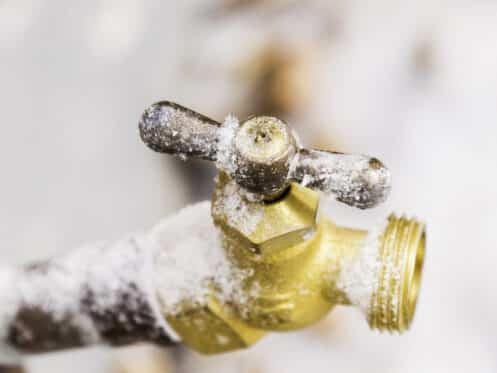Of all of the plumbing issues that could afflict homes in Tacoma, WA, frozen pipes are among the most serious. It’s the kind of problem that can seem like a minor inconvenience at first. However, if you don’t handle the problem correctly, it can turn into a major disaster for your home. That’s because frozen pipes are at risk of bursting, which can, in turn, flood your home.
To get an idea of the kind of damage your home might suffer, consider that the average insurance claim following a burst pipe is an eye-popping $7,000, according to the Insurance Information Institute. The good news is that you can avoid a catastrophe like that if you learn how to safely thaw a frozen pipe, and when to call for help. Here’s everything you need to know.
How to Tell if You Have a Frozen Pipe
The first thing you’ll need to know is how to spot the signs of a frozen pipe. You should know that any pipe exposed to temperatures below 20 degrees Fahrenheit for several hours or more is at risk of freezing. It can even happen at higher temperatures if you have any pipes exposed to drafts, too. The most obvious sign that you have a frozen pipe is if one or more of the sinks in your home suddenly suffer weakened or nonexistent water flow. If you’re dealing with a frozen drainpipe, you might notice an odd smell coming from one or more of your home’s drains.
Another way you might spot a frozen pipe is if you notice frost on any exposed pipe sections in your home. If there’s frost on the outside of the pipe, there’s a good chance there’s ice inside it, too. This can happen to pipes running through uninsulated parts of your home, like basements and garages. It can also happen to pipes running through your home’s attic, where the insulation present keeps heat from reaching them.
What to Do First if You Believe You Have a Frozen Pipe
If you believe your home has a frozen pipe, the first thing you’ll need to do is try and localize the problem. For water supply pipes, you can do this by turning on all the faucets in your home. If one or more of them don’t have water flowing to them, this means the problem is somewhere in their supply lines. For multiple sinks, inspect the supply lines before the point where they split off to feed each affected sink. For a single sink, look at its supply line, beginning under the sink and working your way backward.
If it’s a drain that you think is frozen, the same logic applies. If the problem affects multiple drains, the frozen section is likely somewhere in a main drain line. If it’s a single sink, the problem may be right underneath the sink itself.
Once you locate a frozen supply pipe somewhere in your home, you should turn off your home’s water supply immediately. The reason for this is simple. It’s that there’s always a chance that your frozen pipe has already burst. There’s also a chance that there’s more than one pipe section affected, so it’s best not to take any chances by leaving the water on. Then, you should turn on the affected sinks. This will provide a way to relieve the pressure inside the pipes as the ice thaws.
Safely Thawing a Frozen Pipe
Your next task after finding the affected section of pipe is to slowly thaw it out. It’s important to do this in a controlled manner so you don’t end up harming your pipes in the process. The first step is to visually inspect the frozen section of pipe to look for any signs of splits, damage, or deformation. If anything about the pipe looks odd, or if you can’t be certain there’s no damage, your best bet is to immediately call a professional plumber.
If the frozen pipe section looks like it’s intact and undamaged, you can proceed to thaw it out. The simplest way to do it is to soak some towels in hot water, wring them out, and wrap them around the frozen pipe. You will need to replace the towels every 10 to 15 minutes or so, depending on the temperature in your home. Doing this should melt the ice in the pipe over about an hour or two.
For a slightly neater way to thaw your frozen pipe, you can use a small heating pad in place of the wet towels. If you choose this method, keep the heating pad on low and leave it on for as long as it takes to thaw the pipe. This is the best way to avoid doing any inadvertent damage to your pipes in the process.
If you can’t quite reach the frozen section of pipe, you can place a space heater nearby to apply heat indirectly. Or, if you have the patience, you can use a hairdryer to do the same thing. In either case, you should resist the urge to apply extreme heat too close to the pipe. Otherwise, you risk damaging the pipe as the ice thaws.
Checking for Damage
Once you believe that there’s no more ice in your affected pipe, the next step is to partially turn your home’s water supply back on. Once you do that, examine the section of pipe that was frozen and look for signs of leaks or other damage to the pipe. If you don’t see any, check the faucets that previously had little or no water supply to see if they’re running. If everything seems to check out, fully restore your home’s water supply and repeat the inspection. If there are no visible leaks and the water flow to your faucets is back to normal, you’ve likely succeeded in safely thawing your pipes.
It’s important to remember, however, that your home’s plumbing is more delicate than you might imagine. It isn’t designed to deal with ice, and not every type of damage is visible to the untrained eye. For that reason, you should always consider calling Hunt’s Services for help when you have a frozen pipe, especially if you’re not confident in your DIY skills.
Prevent Future Freezes
To prevent frozen pipes, consider having a plumber insulate exposed pipes, especially in areas prone to cold, like basements and attics. Letting a trickle of water run from faucets during extreme cold can prevent freezing. Also, keep your home’s temperature consistent during cold snaps and consider smart home devices to monitor temperatures in critical areas. Regularly inspect your plumbing for any cracks or leaks, as even small vulnerabilities can lead to big problems in freezing temperatures. Remember, prevention is key to avoiding the stress and cost of dealing with frozen pipes.
Contact Tacoma’s Trusted Plumbing Team
Here at Hunt’s Services, we’ve served the residents of Tacoma for over a decade, offering comprehensive plumbing, HVAC, sewer and drain, and electrical services. Our fully licensed and insured team of expert plumbers can help you thaw a frozen pipe without risking additional damage to your home. We can also help you prevent issues in the first place. We’re a Better Business Bureau-accredited business with an A+ rating, so you can be confident you’re working with the best when you call on us. Our countless five-star customer reviews provide an even further testament to that. So, for frozen pipes and all other plumbing services for your Tacoma home, call the experts at Hunt’s Services today.




